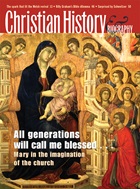Uniting John's portrayal of Mary at the wedding at Cana (the beginning of Jesus' earthly ministry) and at the foot of the cross (the end) is what we might call "the theme of the royal mother." John stresses Mary's maternal relationship to Jesus; his use of the term "mother of Jesus" seems to convey a certain reverence, much as it does in Luke's portrayal of the nascent Church gathered in the upper room, waiting for the coming of the Holy Spirit (Acts 1:14).
"Hail, King of the Jews!"
This maternal relationship of Mary to Jesus is linked to John's emphasis on Jesus' kingship, particularly in the context of his passion. Many Bible scholars have noted how John goes to some length to stress that Jesus died as a king. Unlike the other evangelists, John shows how Jesus' claim to kingship was made a major component of his trial before Pilate (18:33, 36-37). The Roman soldiers mock Jesus with the words, "Hail, King of the Jews!" (19:2) At the last it is Jesus' assertion of his kingship that becomes the decisive charge leading directly to his condemnation (19:12-15). Although the other gospels do speak of the sign over Jesus' cross identifying him as "King of the Jews" (Matthew 27:37; Mark 15:26; Luke 23:38), only in John does this designation become a point of controversy between Pilate and Jesus' accusers (John 19:18-22), thereby drawing more explicit attention to it. In John's account Jesus is even buried in a garden (19:41), like His royal ancestors, the covenanted kings of Judah (2 Kings 21:18, 26). Jesus' cross, then, is inseparable from his kingship.
Now it is in connection with Jesus' kingship on the cross that John speaks of "the mother of Jesus" (19:25). In placing this description of Mary in this context of kingship, John summons to mind the biblical tradition of the queen mother. Biblical kings sometimes had numerous wives, but they had only one mother, and she was a person of considerable prestige and power. Described as wearing a crown (Jeremiah 13:18) in the royal court (22:26; 29:2), the king's mother, the gebira, was regarded with reverence by his subjects.
"Mother of my Lord"
To gain a proper sense of the difference between a biblical king's wife and his mother, one need only compare two scenes found close together in the First Book of Kings. In the first of those scenes, Bathsheba "bowed down and did homage" to her husband David (1:16); in the second, however, her son Solomon "rose up to meet her and bowed down to her, and sat on his throne and had a throne set for the king's mother; so she sat at his right hand" (2:19).
Such regard for the queen mother was most conspicuous in the line of the covenanted Davidic kings, Solomon being the first. We observe that in the passion accounts Jesus is not called the "King of Israel," but specifically "the King of the Jews." It is the royal house of Judah that is envisaged. Now in all but two instances the Books of Kings explicitly name the mothers of the kings of Judah, in striking contrast to the uncovenanted kings of Israel. John's simple reference to "the mother of Jesus," then, evokes this ancient institution of Judah's royalty. Mary takes her place as the last and greatest of the queen mothers of Judah. (In Luke this evocation is conveyed by the expression "mother of my Lord" in 1:43).
Copyright © 2004 by the author or Christianity Today/Christian History
& Biography magazine.
Click here for reprint information on Christian History & Biography.

Support Our Work
Subscribe to CT for less than $4.25/month





























